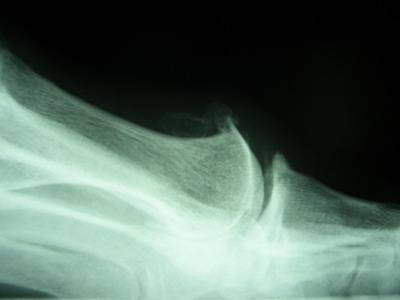Osteoarthritis
Hallux rigidus is a fairly common, and usually painful, condition of the foot. The great toe joint (first metatarsal-phalangeal joint) is subjected to a great deal of stress with the thousands of steps we take each day. Its no wonder that it often presents as the first joint with bothersome osteoarthritis. This is a mechanical “wear & tear” type of arthritis. It does not “spread” to other joints. Some foot types (e.g. flatfoot) are more prone to this disorder than others.
As the arthritis progresses, the formation of bone spurs (marginal osteophytes) around the joint increasingly restricts motion and causes inflammation and pain of the surrounding soft tissues. The problem usually starts with motion already restricted because of abnormal structure or function. We call this condition hallux limitus, when motion is severely restricted or absent, we call it hallux rigidus. When there is extensive spurring around the joint a hard bony mass may be present along the top margin of the great toe joint. This is referred to as a dorsal bunion. It should not be confused with the bunion deformity termed hallux valgus. It is not uncommon for hallux valgus and hallux limitus/ rigidus to affect the same joint at the same time.
The treatment of hallux limitus/ rigidus depends of the severity of the arthritic changes, the degree of pain or functional impairment, the age and health status of the patient, lifestyle considerations, the success or failure of previous therapies, and the personal preferences of the patient. Conservative therapies include selecting proper foot-wear and wearing functional foot orthotics to correct faulty biomechanics. In some cases surgery is the best option to improve joint function and relieve the pain. The podiatric surgeon has the choice of many procedures. Choosing the right procedure is as important as performing it skillfully.
Complications of surgery are not common, but include infection of soft tissue and/or bone, slow healing of skin or bone, irritation from fixation pins or screws, nerve entrapment, reaction to the foreign material (suture material, pins, screws, or implants), excessive swelling, excessive scarring, excessive stiffness , and recurrence of the problem. Occasionally, other parts of the foot may become painful as a result of altered structure and function. Rarely, some complications may require a second surgery to correct the problem. While these complications are rare, they should be weighed against the difficulty that you are experiencing to determine whether surgery is an acceptable risk for your condition. This is an important part of the process.

Xray image showing osteoarthritis
Symptoms
- Pain and occasional swelling of the great-toe joint.
- Discomfort is deep inside the joint and aggravated by walking.
- A hard bony mass (dorsal bunion) may be present above the joint, this may rub on shoes.
- A perceived stiffness of the joint with difficulty raising the heel off the ground.
- There is sometimes considerable pain with the first few steps after arising.
- The pain is often intermittent, with exacerbations following certain activity levels.
Causes
- Abnormality in foot function, particularly a pronated or flat foot.
- Family history of the problem.
- There may be a history of previous trauma to the joint.
- Mal-alignment of the joint secondary to a bunion (hallux valgus) deformity.
- Generalized laxity of the ligaments.
- Previous surgery on the great toe (first metatarsal-phalangeal) joint.
- A long or elevated first metatarsal segment.
- Abnormally shaped joint surfaces.
What you can do
- Wear sensible shoes with good arch support and a fairly firm sole.
- Stiff-soled hiking-type boots will decrease flexion across the joint and diminish irritation.
- If tolerated, take an over-the-counter anti-inflammatory drug such as ibuprofen when the joint is painful.
- Change your activities or sports to ones that are less stressful on the joint. For example swim instead of jog.
- Consult your podiatrist for a proper evaluation which will probably include x-rays.
What the doctor may do
- Inject steroid and local anesthetic into the joint to reduce inflammation.
- Prescribe modifications to your shoes.
- Prescribe functional orthotics to correct faulty foot function, and diminish irritation to the joint.
- Recommend surgery to improve function or relieve pain.
Other causes of pain at the great toe joint
- Bunion deformity (hallux valgus)
- Injury to the soft tissue structures around the first metatarsal-phalangeal joint.
- Fracture of the great toe or first metatarsal.
- Tight shoes may cause pain at an otherwise normal joint.
- Sesamoiditis, this is an inflammation of one or both small bones which rest in tendons under the first metatarsal-phalangeal joint.
- Conditions such as gout, rheumatoid arthritis, and infection of the joint.
